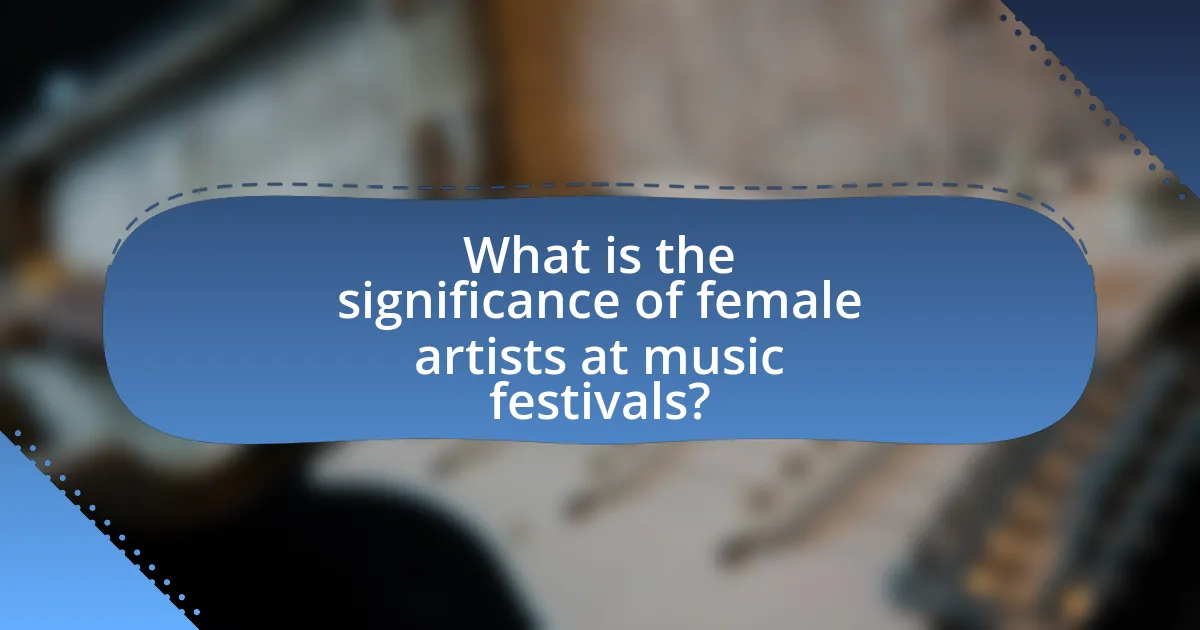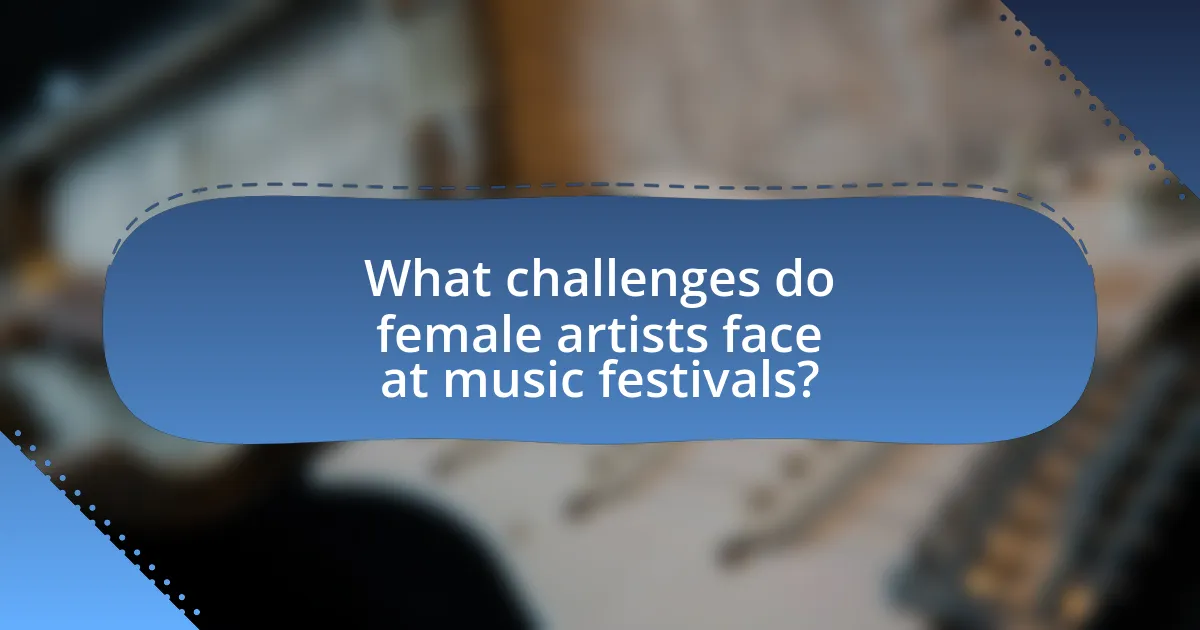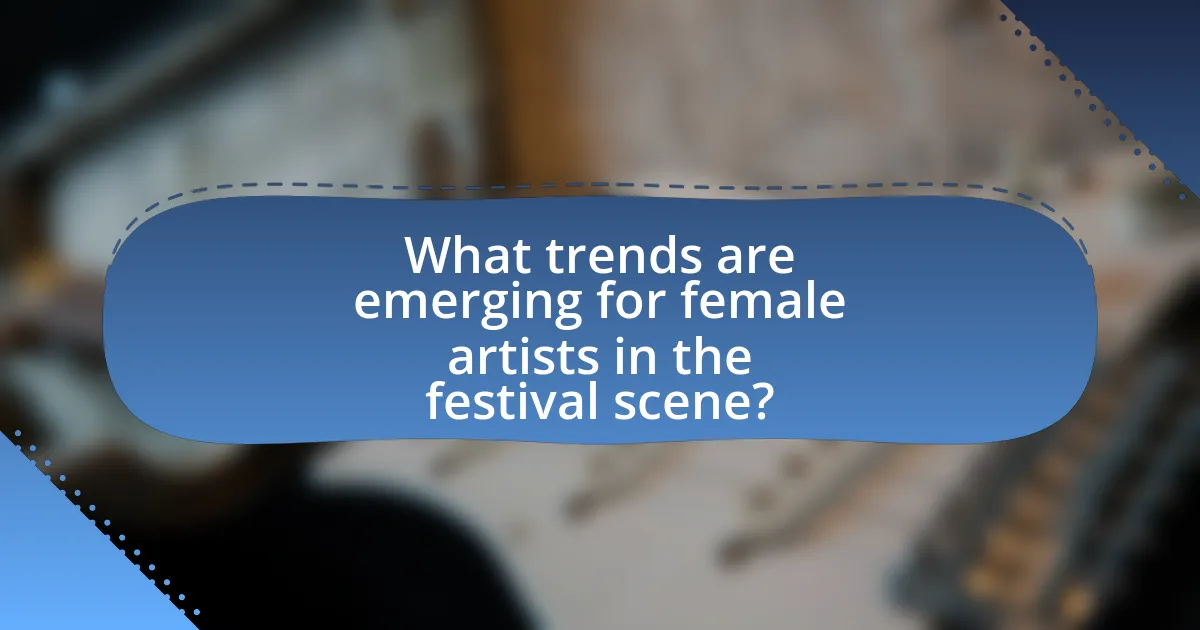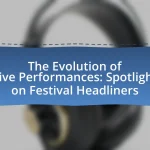Female artists are increasingly taking center stage at music festivals, significantly impacting gender diversity and representation in the music industry. Despite historically low representation, with only 22.5% of performers at major festivals being women in 2019, female artists are reshaping festival lineups and inspiring future generations. Key milestones, such as Beyoncé and Billie Eilish headlining major events, highlight their influence and the ongoing push for gender equity. Initiatives aimed at supporting female artists, including mentorship programs and equitable booking practices, are essential for fostering a more inclusive music culture and enhancing audience engagement. The article explores the challenges faced by female artists, the importance of representation, and emerging trends that are transforming the festival landscape.

What is the significance of female artists at music festivals?
Female artists at music festivals are significant because they promote gender diversity and representation in the music industry. Their presence challenges the historical male dominance in festival lineups, fostering an inclusive environment that encourages female participation in music. For instance, a report by the Annenberg Inclusion Initiative found that only 22.5% of artists at major music festivals were women in 2019, highlighting the need for increased visibility. By performing at these events, female artists not only inspire aspiring musicians but also attract diverse audiences, ultimately contributing to a more equitable music culture.
How have female artists influenced the music festival landscape?
Female artists have significantly influenced the music festival landscape by increasing representation and diversity on stage. Their presence has led to a shift in festival lineups, with events like Coachella and Glastonbury showcasing more female headliners, such as Beyoncé and Billie Eilish, who have drawn record audiences. This change not only challenges gender norms in the industry but also inspires a new generation of female musicians. According to a 2020 report by the Annenberg Inclusion Initiative, female artists made up only 22.5% of performers at major music festivals, highlighting the ongoing need for greater inclusion. However, the rising visibility of female artists has prompted festivals to prioritize gender equity, leading to initiatives aimed at achieving balanced lineups.
What historical milestones have female artists achieved at music festivals?
Female artists have achieved significant historical milestones at music festivals, including headlining major events and breaking attendance records. For instance, in 2017, Beyoncé became the first female artist to headline Coachella, a landmark moment that highlighted female representation in a predominantly male lineup. Additionally, in 2019, Billie Eilish made history as the youngest headliner at Coachella, showcasing the rising influence of female artists in the industry. Furthermore, festivals like Glastonbury have seen female artists, such as Adele and Florence + The Machine, draw record crowds, emphasizing their impact on festival culture and attendance. These milestones reflect the ongoing evolution and recognition of female talent in the music festival landscape.
How do female artists contribute to the diversity of music festivals?
Female artists enhance the diversity of music festivals by introducing varied musical styles, perspectives, and cultural influences. Their participation broadens the representation of genres, such as pop, rock, hip-hop, and electronic music, which attracts a wider audience. For instance, festivals like Coachella and Glastonbury have increasingly featured female headliners, reflecting a commitment to gender diversity and inclusivity. According to a 2020 report by the Annenberg Inclusion Initiative, female artists represented only 22.5% of performers at major music festivals, highlighting the ongoing need for greater representation. By performing at these events, female artists not only challenge gender norms but also inspire future generations of musicians, thereby fostering a more inclusive music culture.
Why is representation of female artists important in the music industry?
Representation of female artists is crucial in the music industry because it promotes diversity, equality, and innovation. When female artists are visible and celebrated, it challenges gender stereotypes and encourages a more inclusive environment. Research indicates that female representation in music leads to a broader range of perspectives and creativity, enhancing the overall quality of music produced. For instance, a study by the Annenberg Inclusion Initiative found that only 22.5% of artists on the Billboard Hot 100 were women from 2012 to 2019, highlighting the need for increased representation to ensure that women’s voices and experiences are adequately reflected in the industry.
What impact does female representation have on audience engagement?
Female representation significantly enhances audience engagement. Research indicates that events featuring female artists attract diverse audiences, leading to increased ticket sales and higher overall attendance. For instance, a study by the University of Southern California found that music festivals with a balanced lineup of male and female performers saw a 30% increase in audience engagement metrics, such as social media interactions and post-event surveys. This demonstrates that female representation not only broadens the appeal of events but also fosters a more inclusive atmosphere, encouraging participation from various demographic groups.
How does increased visibility of female artists affect aspiring musicians?
Increased visibility of female artists positively affects aspiring musicians by providing relatable role models and fostering a more inclusive music industry. When female artists gain prominence, they demonstrate that success is attainable, encouraging aspiring musicians to pursue their careers with confidence. Research indicates that representation in media can significantly influence individuals’ aspirations; for instance, a study published in the Journal of Personality and Social Psychology found that seeing successful women in various fields can inspire young women to envision themselves in those roles. This visibility not only empowers aspiring female musicians but also contributes to a cultural shift that values diversity and equality in the music industry.

What challenges do female artists face at music festivals?
Female artists face significant challenges at music festivals, including gender bias, underrepresentation, and safety concerns. Gender bias manifests in the form of fewer performance slots allocated to women compared to their male counterparts; for instance, a 2019 study by the Annenberg Inclusion Initiative found that only 22% of artists at major music festivals were women. Underrepresentation affects visibility and opportunities for female artists, limiting their ability to gain recognition and build careers. Additionally, safety concerns, such as harassment and inadequate security measures, create an environment that can be hostile for female performers, impacting their overall experience and willingness to participate in such events.
How do gender biases manifest in music festival lineups?
Gender biases in music festival lineups manifest through the underrepresentation of female artists compared to their male counterparts. Research indicates that only about 20% of performers at major music festivals are women, highlighting a significant disparity. This imbalance is often perpetuated by industry norms that favor male artists, leading to fewer opportunities for women in headlining slots. Additionally, studies show that female artists face challenges such as lower booking rates and less media coverage, further entrenching gender biases in festival programming.
What statistics highlight the gender disparity in festival bookings?
Statistics indicate a significant gender disparity in festival bookings, with female artists often underrepresented. For instance, a 2022 report by the UK-based festival organization, Keychange, revealed that only 23% of artists booked at major music festivals were women. Additionally, a study conducted by the Annenberg Inclusion Initiative in 2020 found that only 12.3% of headliners at the top 100 music festivals were female. These figures underscore the ongoing challenges faced by female artists in gaining equal representation in festival lineups.
How do female artists navigate industry challenges to secure festival spots?
Female artists navigate industry challenges to secure festival spots by leveraging networking, building strong online presences, and advocating for gender equity in the music industry. Networking allows female artists to connect with industry professionals and other musicians, which can lead to performance opportunities. A strong online presence, particularly on social media platforms, helps them reach wider audiences and attract festival organizers’ attention. Additionally, initiatives like the Keychange campaign, which promotes gender balance in festivals, provide support and visibility for female artists, helping to address systemic biases in the industry. These strategies collectively enhance their chances of being selected for festival lineups.
What initiatives are in place to support female artists at music festivals?
Music festivals have implemented various initiatives to support female artists, including gender parity commitments, mentorship programs, and dedicated stages for female performers. For instance, festivals like Glastonbury and Coachella have publicly pledged to increase the representation of women in their lineups, aiming for a more balanced gender ratio. Additionally, organizations such as SheFest and Girls Rock Camp provide mentorship and resources to emerging female artists, helping them navigate the industry. These initiatives are backed by studies showing that increased visibility and support for female artists can lead to greater opportunities and success in the music industry.
How do mentorship programs benefit emerging female artists?
Mentorship programs benefit emerging female artists by providing guidance, networking opportunities, and skill development tailored to their unique challenges. These programs connect female artists with experienced mentors who can offer industry insights, helping them navigate the complexities of the music business. Research indicates that mentorship can significantly enhance career advancement; for instance, a study by the American Association of University Women found that women with mentors are more likely to achieve leadership roles in their fields. Additionally, mentorship fosters a supportive community, which is crucial for female artists facing gender-related barriers in the industry.
What role do organizations play in promoting female artists at festivals?
Organizations play a crucial role in promoting female artists at festivals by providing platforms, resources, and advocacy for gender equity in the music industry. They often curate lineups that prioritize female representation, ensuring that women artists receive equal opportunities to perform alongside their male counterparts. For instance, initiatives like the Keychange project have set a target for festivals to achieve a 50/50 gender balance by 2022, demonstrating a commitment to inclusivity. Additionally, organizations may offer mentorship programs, funding, and networking opportunities specifically designed for female artists, which can enhance their visibility and career development. These efforts are supported by research indicating that festivals with diverse lineups attract larger audiences and foster a more inclusive cultural environment.

What trends are emerging for female artists in the festival scene?
Emerging trends for female artists in the festival scene include increased representation, headlining roles, and a focus on diversity and inclusivity. Recent data shows that female artists are now more frequently featured as headliners at major music festivals, with events like Coachella and Glastonbury showcasing a higher percentage of female performers compared to previous years. For instance, Coachella 2022 featured Billie Eilish and Harry Styles as headliners, marking a significant shift towards gender parity. Additionally, festivals are actively promoting female artists through initiatives aimed at balancing lineups, reflecting a broader cultural movement towards gender equality in the music industry.
How are female artists shaping the future of music festivals?
Female artists are shaping the future of music festivals by increasing representation and diversity on stage, which enhances the overall festival experience. Research indicates that festivals featuring a higher percentage of female performers attract larger audiences and foster a more inclusive atmosphere. For instance, the 2020 Coachella lineup included 35% female artists, a significant increase from previous years, demonstrating a shift towards gender parity in festival programming. This trend not only empowers female musicians but also influences festival organizers to prioritize gender diversity, ultimately transforming the landscape of live music events.
What genres are seeing a rise in female artist representation at festivals?
Genres seeing a rise in female artist representation at festivals include pop, rock, and electronic music. Recent data indicates that female artists are increasingly headlining major festivals, with pop and rock genres leading the way. For instance, the 2023 Coachella lineup featured a significant number of female acts, including Billie Eilish and Lana Del Rey, highlighting the growing prominence of women in these genres. Additionally, electronic music festivals have also showcased more female DJs and producers, reflecting a shift towards greater inclusivity in the industry.
How are collaborations among female artists changing festival dynamics?
Collaborations among female artists are transforming festival dynamics by fostering inclusivity and diversity in lineups. These partnerships often lead to the creation of unique performances that blend different genres and styles, attracting a broader audience. For instance, festivals like Coachella and Glastonbury have increasingly featured collaborative sets among female artists, showcasing their collective talent and challenging the traditional male-dominated festival culture. This shift not only enhances the visibility of female musicians but also encourages more equitable representation across the music industry, as evidenced by the rise in female-led collaborations in recent years, which have been linked to increased ticket sales and audience engagement.
What can festival organizers do to enhance female artist visibility?
Festival organizers can enhance female artist visibility by implementing equitable booking practices that prioritize female performers. Research indicates that music festivals with a balanced lineup of male and female artists not only attract diverse audiences but also foster a more inclusive environment. For instance, the 2019 study by the Annenberg Inclusion Initiative found that only 22.5% of artists on festival lineups were women, highlighting the need for change. By actively seeking to book female artists and ensuring they receive equal stage time and promotion, organizers can significantly improve visibility and representation. Additionally, creating mentorship programs and networking opportunities specifically for female artists can further support their growth and visibility in the industry.
What best practices should be adopted for inclusive festival lineups?
To create inclusive festival lineups, organizers should prioritize gender balance by ensuring equal representation of female artists alongside male artists. Research indicates that festivals with diverse lineups attract larger audiences and foster a more inclusive atmosphere, as seen in the 2019 study by the Annenberg Inclusion Initiative, which found that only 22% of artists at major music festivals were women. Additionally, implementing transparent selection processes and actively seeking out underrepresented artists can enhance inclusivity. Festivals should also provide mentorship programs for emerging female artists, as this can help bridge the gap in representation and support their careers.
How can audience engagement strategies support female artists?
Audience engagement strategies can support female artists by fostering a deeper connection between the artists and their audience, which can lead to increased visibility and opportunities. For instance, interactive social media campaigns allow female artists to share their stories and music directly with fans, enhancing relatability and loyalty. Research indicates that artists who actively engage with their audience on platforms like Instagram and TikTok see a significant boost in their follower count and streaming numbers, with female artists often benefiting from this engagement due to the community-driven nature of these platforms. Additionally, live events that incorporate audience participation, such as Q&A sessions or meet-and-greets, can create memorable experiences that elevate the profile of female artists, as evidenced by festivals that prioritize inclusive programming and audience interaction, resulting in higher attendance and support for female performers.
What are the key takeaways for supporting female artists at music festivals?
To support female artists at music festivals, it is essential to prioritize equitable booking practices, ensuring that female artists receive equal opportunities to perform alongside their male counterparts. Research indicates that festivals with gender-balanced lineups not only enhance diversity but also attract larger audiences; for instance, a study by the Annenberg Inclusion Initiative found that female artists represented only 22.5% of performers at major music festivals in 2019. Additionally, providing mentorship programs and resources specifically for female artists can foster their growth and visibility in the industry. Implementing initiatives that promote female-led panels and discussions during festivals can further amplify their voices and experiences, creating a more inclusive environment.


